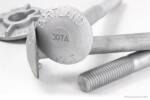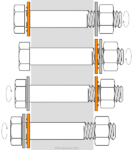Newest FAQs
Timber bolts, also referred to as economy bolts in the Pacific Northwest, are designed with a round oversized head which eliminates the need for a washer underneath the head. The underside of the head has two nubs which bite into wood and prevent the head from spinning in the timber. The nubs under the head... Read more

The tolerances for A193-B7 are governed by section 4 of the specification, which states, “Material and fasteners supplied to this specification shall conform to the requirements of Specification A 962/A 962M. These requirements include test methods, finish, thread dimensions, marking, certification, optional supplementary requirements, and others.” Studs (also known as All Thread Rods) would be... Read more
ASTM F1554 does specifically state in Section 6.4 that the manufacturing company can substitute weldable F1554 Grade 55 material in place of F1554 Grade 36 material at the option of the manufacturing company. So technically your supplier is correct that they can substitute F1554 Grade 55 for F1554 Grade 36 at any time, as long... Read more
According to the Research Council on Structural Connections (RCSC December 31, 2009 edition), an F436 washer is used in addition to a DTI washer with an A325 structural bolt. RCSC’s Specification for Structural Joints Using ASTM A325 or A490 Bolts, Section 6 Use of Washers, states that a ASTM F436 washer is always used, but... Read more

F1554 Grade 36 bolts are considered weldable, and the current version of the specification specifically states this. Section 6.4 of the ASTM 1554-15 specification reads as follows: 6.4 Weldability — Grade 36 anchor bolts are considered weldable F1554 also allows for weldable Grade 55 to be substituted at the manufacturer’s discretion. The specification also notes... Read more
Yes. There is a common misconception that ASTM F436 hardened washers are only available in the standard circular sizes. However, the F436 specification covers four defined styles of hardened washers, while also allowing for custom dimension washers as well. The four defined styles are: Circular Beveled Clipped Extra Thick These four styles each have specific tables... Read more
The ASTM A36 specification reads as follows: When the steel is to be welded, a welding procedure suitable for the grade of steel and intended use or service is to be utilized. See Appendix X3 of Specification A6/A6M for information on weldability. Appendix X3 of ASTM A6/6M states: Weldability is a term that usually refers... Read more
Tie rods are attached by sliding a gusset plate or knife plate, which is fastened to a structure, in between the ears of a clevis. A clevis pin or A325 structural bolt, is then assembled through the pin holes on the clevis and through the hole in the plate. Gusset plates are attached to the... Read more

A307 bolts, rods, and studs are not always weldable. For this grade to be weldable it must meet the supplementary requirement S1 of the ASTM A307 specification. This supplement provides assurances of weldability by additional chemical composition restrictions and by a carbon equivalent formula. In addition, “Because of the embrittling effects of welding temperatures on... Read more
Answer: SAE J429 is a Society of Automotive Engineers specification for bolts covering “the mechanical and material requirements for inch-series steel bolts, screws, studs, sems1, and U-bolts used in automotive and related industries in sizes to 1-1/2 in inclusive.” From SAE J429 regarding studs: “The term ‘stud’ as referred to herein applied to a cylindrical... Read more
